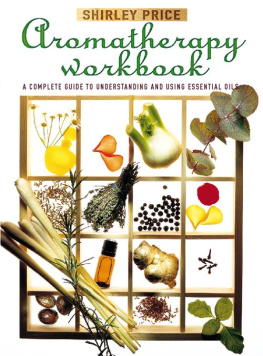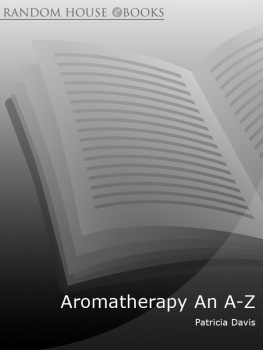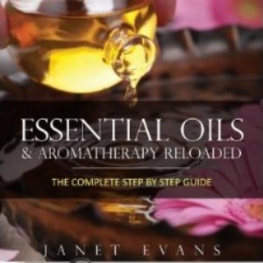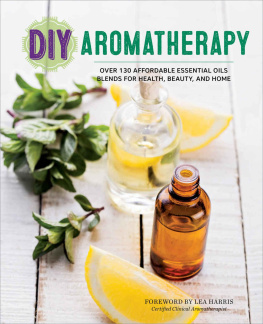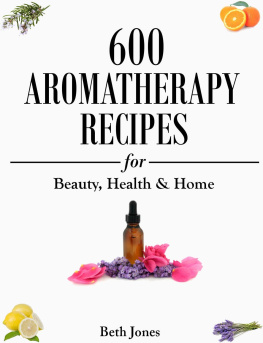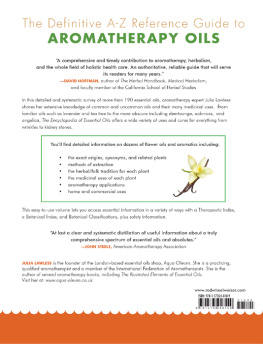
Fragrant oil brings joy to the heart and a friends support is as pleasant as perfume.
Proverbs 27 v. 9
To write a complete book on aromatherapy is an almost impossible task. Not only would it need to be several volumes thick in order to cover every essential oil in use, but as new facts are being discovered continuously, a new edition would be necessary every year.
My aim, therefore, is to write about as many facets of aromatherapy as possible, while still maintaining a simple easy-to-read style. At the end of the book there is space for you to make your own notes and observations.
Since writing my first book on aromatherapy in 1982, the interest and enthusiasm of both my husband Len and myself has increased at least three hundredfold in one way or another.
A few years ago, we were becoming increasingly aware of the difficulty of obtaining essential oils of therapeutic quality from British suppliers, whose main concern is the much larger perfume and food industry market. Their requirements are different from those of aromatherapy and not so stringent as far as the wholeness of a natural oil is concerned. We therefore decided to attend an essential oil exhibition in France, which was solely for those requiring essential oils for health reasons, and as such, interested Len and myself very much indeed. It was a small, but wonderful exhibition; Len attended one or two of the lectures while I was making contact with the suppliers.
Buying essential oils is very much a matter of trust and liking people, and we were fortunate enough to find there one supplier with whom we had an immediate empathy. He even invited us to his home to see the area and the plants from which would come the oils we would be buying.
We spent four wonderful days viewing the fields and meeting the farmers. Already I was feeling excited that at last we were going to be able to give our therapists, mail-order clients and retail customers genuine, untampered-with essential oils, specifically for promoting the health and vitality of the body, rather than those imported purely for use in perfumes and flavourings, most of which need to be standardized, or have synthetics added to them.
We were finding ourselves visiting France several times during a year, to order the oils we would need and to watch (even take part in) the planting, hoeing, harvesting and distilling of the plants themselves, so we bought an old farmhouse in the region! We take groups of aromatherapists and interested clients to a converted ex-monastery two miles from our farmhouse, from where, for a week, we visit the fields, discover the medicinal plants on a mountain walk and watch the distillation process fascinating! We take them to noted restaurants in the area, to the local caves (the wine-tasting cellars) and to a well-known market, passing on the way fields of lavandin (the gloriously purple relative of the true lavender plant) and the incredibly striking fields of massive sunflowers, all with their bright yellow heads facing the morning sun. All this under an amazingly blue sky, with the green grass and cornfields (which contain a host of vermillion red poppies) backed by the awe-inspiring mountains the whole scene, with its accompanying aromas, needs to be experienced to be fully appreciated.
Why am I telling you all this? Because I want you to get a feel for the plants which provide us with their miraculous quintessence, and to appreciate, as I do now, that essential oils are not just powerful liquids in little glass bottles, but are representative of the individual plants and families from which they come, giving us their vibrant energy to help us to improve the quality of our lives.
Neither let us forget that plants such as these have, since life began on this planet, provided us with medicines out of the earth as it tells us in the Old Testament. The amazing energy which some of us, including myself, call God, certainly completed his work incredibly well: a few moments spent thinking of the wonders of Nature and the intricate workings of the human body (and its ability to heal itself under normal circumstances) should be enough to convince us of the Power surrounding us. Would that we were all able to respect what we were given, treat it with care and use Natures gifts efficiently to maintain good health all our lives.
My hope is that this book will help people to respect essential oils and to use them with efficiency and love.
The Mists of Time
When researching the history of aromatherapy it is well to remember that the word itself was only brought into being in the early 20th century, and its strict meaning is a therapy using only the aromas (i.e. the essential oils) from plants, not the plants in their entirety (i.e. herbalism). Thus, much of the history connected with aromatherapy is in reality the history of the use of whole plants for medicinal use essential oils, especially as we know them, came later. Indeed, there are cave paintings recognized as being many thousands of years old which may be interpreted as showing the general use of plants for medicinal purposes. Phytotherapy (meaning a therapy using plants) encompasses many different ways of doing this from the use of the shoots as in gemmotherapy; parts, or the whole, of the adult plant as in herbal medicine, Bach Flower Remedies and homoeopathy to the use of aromatic plant extracts only, as in aromatherapy and its non-medicinal counterpart, perfumery.
The origins of aromatherapy are lost in the mists of time, long before records of any kind were kept, though it is believed that crude forms of distillation, which is the main method by which essential oils are obtained, were practised in Persia, Egypt and India thousands of years ago.
Aromatic extracts were, and still are, taken from plants in many different ways; expression, enfleurage, maceration, solvent extraction and the method par excellence for aromatherapy distillation. Distillation was originally used mainly for the extraction of exotic flower waters, such as rose and orange flower; the amount of essential oil produced was hardly perceptible, as flowers contain very little essential oil.
No-one can say for sure whether the extraction and use of aromatic material began in India or Egypt suffice it to say that in both these countries the use of plants was, for thousands of years, an important part of their culture.
The Indian Story
In India the use of plants and plant extracts as medicines has been continuous from at least 5,000 years ago up to the present day. Ayurvedic medicine, as it is called, is unique in this respect, and one of the oldest known books on plants, Vedas, is Indian. This book not only mentions many aromatic materials, such as sandalwood, ginger, myrrh, cinnamon and coriander but also indexes the various uses of these plants for religious and medicinal purposes. Ayurvedic medicine, however, remained mainly confined to the area where it developed until fairly recently.
The Influence of Egypt
More is known about the development of plant use in Egypt and the surrounding Mediterranean countries; in fact the Nile valley became known as the Cradle of Medicine and among the plants brought to this area were cedarwood, frankincense, myrrh and cinnamon.
In Egypt 5,000 years ago, perfumery was so closely linked with religion that each of the gods was allotted a particular fragrance, with which their statues were sometimes anointed. It was the priests who formulated the aromas and the Pharaohs of the time asked them for perfumes with which to anoint themselves in times of prayer, war and love.
Next page
